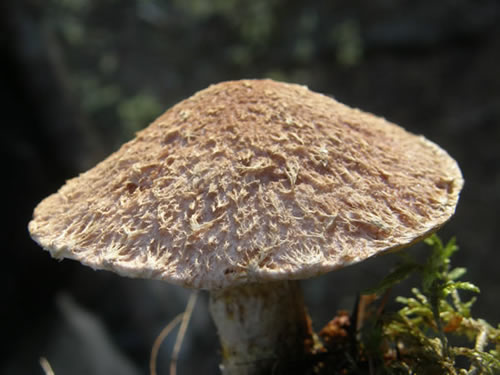  |
|
| | |
Along the Mushroom Trails - Understanding Mushrooms |
| | |
 |
Mushrooms are the fleshy parts of fungi and seem to pop up in a large variety of conditions. On these pages you'll find out about stipes and gills, pores and spores as we take a close look at the parts of mushrooms and develop a better understanding of these interesting organisms.
We are extremely grateful to Gerry Ansell of Victoria, BC for his amazing knowledge and valuable assistance. |
| |
 |
A universal veil is a tissue that encloses the entire button mushroom protecting it in its immature state. This thin veil is broken as the mushroom grows. It may leave warts or fragments on the mature mushroom or disappear altogether. This is a young specimen and has a universal veil (the white) below the cap and a bulbous base to the stipe or stem. |
| | |
 |
The scales on the cap of this Amanita Mushroom are the remnants of the universal veil that enclosed the mushroom when it was young. |
| | |
The first part of a mushroom that draws our attention is the cap or pileus.
This fleshy part comes in many shapes, colours and sizes. |
 |
| |
| |
|
The red disk at the apex of the cap in this mushroom is just one example of the many different and distinguishing characteristics found in mushroom caps.
The rest of the cap and the stem are scaly. |
| | |
 |
The cap of the Delicious Milk Cap, Lactarius rubrilacteus, features a depression in the centre. |
| | |
 |
Here is a Shaggy Mane Mushroom, Coprinus comatus, with a cylindrical cap that is about to deliquesce, a process in which mushroom gradually breaks down and decays. The fruiting bodies will dissolve into a black ink substance which is called deliquescence, with the gill tissue turning into a dark inky liquid. This is a unique method of spore dispersal typical of the species Coprinus. |
| | |
|
Cap Fungi like this Orange Peel Fungus, Aleuria aurantia, have unusual cup- or saucer-shaped caps. They have no pores or gills but a spore bearing surface inside the cup.
The rest of the cap and the stem are scaly. |
| | |
 |
Some mushrooms have a feature called a cap cuticle. This is a layer above the cap contex that helps to protect the flesh from deteriorating. You can see the slimy cap cuticle in this specimen of Short-stemmed Slippery Jack, Suillus brevipes. |
| | |
|
Another unique type of mushroom cap which helps one identify mushrooms is the fibrous one as shown in this Bolete mushroom. |
| |
|
This photograph shows a morel with its typical and unique cap which is spongy and honeycombed with numerous fissures.
This species of mushroom doesn't have a cap with gills underneath as with most common mushrooms. Instead, it has spore-producing sacs along the insides of its pits or wrinkles. |
| | |
|
|
Many mushrooms do not have the regular, familiar-shaped cap. This one is convoluted, all folded and contorted and somewhat brain-like. These mushrooms do not have gills but a fertile spore-bearing surface on the outside. |
| |
The cap surface shown here on a Bolete mushroom is called an areolate cap, often an important identification feature.
This type of cap is sometimes just called cracked. |
 |
| |
| |
|
In contrast to the mushroom caps with cracked surfaces is this specimen which has a scaly finish. |
| |
|
Other mushrooms have a two-tone coloured cap. |
| |
|
This cross-section of a mushroom cap shows the context or flesh directly under the top layer. Beneath that are the gills. |
| |
|
The classic gilled mushroom has an umbrella shape and gills under the cap, radiating from the stipe or stem.
It is on these gills that the mushroom's spores are produced.
The gills shown here are attached.
|
| | |
|
|
|
Gills are actually called lamellae and have the sole purpose to produce spores. The gills shown here on the left are attached to partially extend down the stipe.
This is a feature know as "decurrent."
On the right the mushroom has decurrent gills and is typical of the genus Clitocybe. |
| | |
|
|
The forking of the gills can be an important feature in helping to identify certain species as illustrated by this Grayling, Cantharellula umbonata. |
| |
|
|
| | |
|
|
Home | All Things Natural Restaurant | Bird's Nest Lounge | Cyber Room | Lagoon Trail | Naturalist's Nook | Wildflower Garden | Woodlands Pathway
Site Map | Inbox | FAQs | News and Updates | Newsletter Information | Games Room | Privacy Policy
All content © Dereila and Sage Innovations
|





















